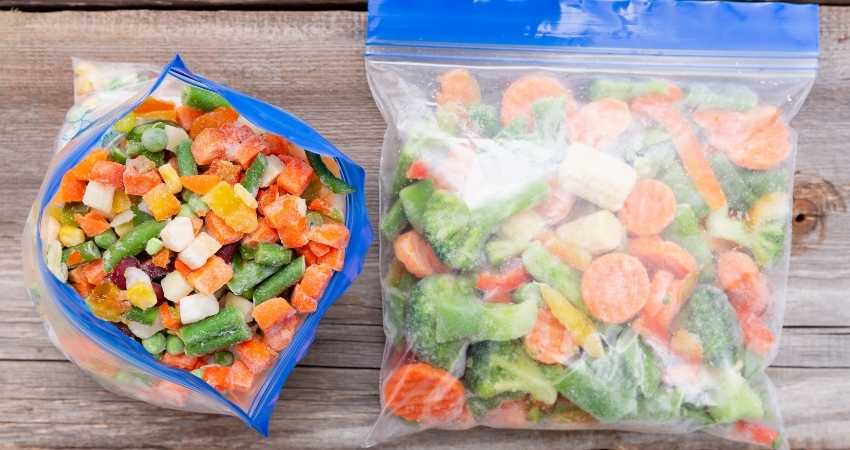The Complete Guide To Food Storage Processes
Is there a right and wrong way to unpack your food items when you get home? Let’s examine what order food should be placed in storage.
Once you arrive home from the supermarket all the frozen items should be stored first. The items that need refrigeration like dairy products, meats and fresh vegetables should be next. Then, the pantry items should be stored last.
In addition to the proper order, the food items should be placed in each compartment in an organized way from top to bottom. In addition, certain items should be located in the front, back or center of the refrigerator.
Let’s have a look at the different storage options and the correct way to store your food items.

Storing Food In The Freezer
The freezer is the very first thing that should be packed once you have arrived home from the supermarket. The reason for this is that you’ll want to get the frozen items you bought into the freezer again before they begin defrosting. Once they have defrosted, you’ll be unable to refreeze them again.
Stick to the 2-hour rule for items requiring refrigeration. If the temperature is above 90 degrees Fahrenheit the limit becomes 1-hour. The sooner you get the food away the better1.
What Food Items Should Be Stored In The Freezer?
Food items that should be stored in the freezer are items that will not last very long in the refrigerator or cabinets. These items will need to be kept frozen until it needs to be used.
For example, bread, extra bottles of milk or blocks of cheese, broth, cookie dough, fresh herbs, and then items required to stay frozen such as frozen vegetable mixes.
In addition, food items that have to be frozen, like ice cream or frozen dinners, you’ll have no choice unless they’ll melt or go bad.

Food That Shouldn’t Be Frozen or Keep In Freezer
The following food items should not be stored in the freezer2:
- Salad – Does not freeze well.
- Raw Eggs – Do not freeze in the shell.
- Hard boiled eggs.
- Homemade eggnog.
- Canned ham.
Disclaimer: Some of links in this article are affiliate links which means I may earn a small commission at no extra cost to you. As an Amazon associate I earn from qualifying purchases.
What Order From Top To Bottom Should They Be Stored In?
When it comes to freezer storage, it will be up to your personal preference which order you would prefer to store your items in. The main goal is to try to keep an organized system with where your food is stored.
For example, you can keep your frozen vegetables and herbs on any level in the freezer. Ensure you keep all of your vegetables and herbs on that level.
It will be the same with meat. You can store your meat on the bottom shelf of the freezer, but make sure to keep all your meat on the same level.
Another essential tip in storing your food in the freezer is to bring your older frozen food items to the front and keep the newer items to the back. It’s essential to maintain a good rotation of food items and don’t end up with old meat or vegetables at the back of the freezer for months and months on end.
Lastly, ensure everything that goes in the freezer is adequately sealed to prevent any frost or freezer burn from occurring.
When storing food in the freezer, always use bags made for the freezer. They are thicker, have space to write the date and the clasps are more secure. They’re on Amazon and more affordable there, freezer bags.
In addition, consider using a vacuum sealer which removes all the air. They don’t cost much and it’s one of those items you wish you acquired a long time ago. Check them out on Amazon by clicking here, vacuum sealers.
Storing Food In The Fridge
After you come home from the supermarket the refrigerator is the second thing that should be packed after the freezer. Your refrigerator is a far more complex thing to stock, as there is a precise way you should store the food items to maximize their freshness and lifespan.
The reason for keeping these food items in a particular order is for hygiene reasons and to prevent any of the other food items in your fridge from cross-contamination with any raw meats. Remember the rear area of the shelves are the coldest part of the fridge3.
Your fridge has been specifically designed to cool different sections at different levels. For example, your vegetable crisper drawer will be cooled well but not too much. You don’t want your fresh produce to freeze because they can freeze quickly.
If your refrigerator is unorganized, removing the items and putting them in the correct spots is a perfect time to clean your shelves, walls and door.
In addition, to being clean, a sanitized fridge means less chance of food borne illnesses and contamination. Don’t forget the baking soda which acts as a wonderful deodorizer.
To keep your refrigerator more organized, consider buying baskets that stick to the walls with suction cups. It’s a great spot to put small items that can sometimes get lost and forgotten.
In addition, you can use a lazy Susan for jars or plastic containers. Check out storage devices for the fridge on Amazon, food storage containers.
What Food Items Should Be Stored In The Fridge?
Food items that need to remain cold to maximize their lifespan are foods that should be kept in the fridge.
This includes foods like:
- Eggs.
- Cheese.
- Butter.
- Milk.
- Most fresh fruit.
- Jams.
- Beverages.
- Juices.
- Fresh vegetables.
- Any item marked as refrigerate after opening.
The cold will help these items stay fresher for longer, prevent them from going bad and give you more time to use them before they turn.
Refrigerators should maintain a temperature between 34 and 40 degrees Fahrenheit4. My new GE fridge was preset at 36 and I keep it right there.
What Order From Top To Bottom Should They Be Stored In?
From top shelf to bottom shelf, the order food should be placed in the fridge should be the following:
Top shelf items should be: Ready to eat foods like cheeses, yogurts, jams, milk and other similar items. The top shelves should be foods that will be consumed without being cooked first5.
Second shelf items should be: Other ready to eat foods like leftovers, cakes, cooked meats, spreads, preserves, eggs and other similar items.
Third shelf items should be: Raw meats like beef, poultry, fish, lamb, etc. These meats should always be sealed properly in their packaging or a tightly sealed container.
Forth shelf/vegetable crisper draw: This shelf should be used for fresh produce like fresh fruit and vegetables.
Fridge door: The door of your fridge is the best place to put your condiments. Most people will keep items like eggs and milk there but it’s not the best location for them because the door is the warmest section of the fridge. You can keep opened bottles of white wine or soda in the door.
Storing Food In The Pantry
Pantry storage is the main focus during my health coaching pantry makeover sessions with my clients.
Food items that can be stored in your cabinets are items considered non-perishable food items.
These items don’t need to be kept at a cold temperature to keep fresh. They only need to be kept in a cool, dark environment.
Items that you can keep in your pantry are the following:
- Canned food items – Tuna, beans, corn, chopped tomatoes, etc.
- Dry food items – rice, pasta, flour, etc.
- Plastic or glass packaged food items: Syrup, vinegar, Worcestershire sauce, etc.
- Dried herbs and spices: Dried herbs (thyme, basil, parsley), barbeque rubs, spices (chicken spice, fish spice), etc.
- Boxed items: Cereals, oats, cookies, crackers, etc.
When it comes to how to store food in your cabinets correctly, this comes down to your personal preference. There is no absolute right or wrong way to stock your shelves.
Even though there is no one correct way to stock your pantry, some ways would make your life easier. Storing the items you use daily on the shelves that are most easily accessible, like at shoulder height. Place other items you don’t use as regularly on higher or lower shelves.
For example, if you eat cereal or oatmeal for breakfast every single day, it would make sense to them keep those items at shoulder height. This way it’s easy for you to grab every morning.
If you only occasionally cook with beans, it makes sense to store them and lesser-used canned items on a higher shelf more out of the way.
Of course, the height of some of your cabinets or shelves may limit you somewhat. Don’t forget, most shelves are adjustable and their height can be adjusted to help keep you organized.
Most kitchen cabinets will have pre-drilled holes in the side with plastic clips which can be moved up and down that secure the shelves.
If you have any questions about this article don’t hesitate to comment below or email us. You can find an email on our contact page.
Read Next – More Food Storage
6 Cheeses That Can Be Left Unrefrigerated
Can Extra Virgin Olive Oil Go Bad? What You Need To Know
The Best Food Storage For Dorm Room Ideas
This Is How Long Lemons Can Stay Frozen For
- FDA: Are You Storing Food Safely? [↩]
- Foodsafety.gov: Cold Food Storage [↩]
- Today: How to keep food fresh in the fridge by storing it in the right place [↩]
- University of Nebraska-Lincoln: Refrigerator and Freezer Storage [↩]
- State Food Safety: Fridge Storage for Food Safety [↩]
